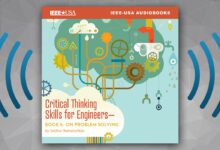
Imagine, for a moment, a world where investors had rejected proposals:
- For one-stop, online shopping for virtually any product
- For a completely electric automobile that can travel 200 miles without a charge
- For the ability to stream films and other programming directly to your favorite electronic device
Fortunately, none of these ideas were rejected. And San Francisco consultant Sridar Ramanathan says we can thank investors who used their curiosity and open-mindedness to see the huge potential for Amazon, Tesla and Netflix.
“In hindsight, these proposals all look like easy bets,” he adds. “But at the time, they most certainly were not. It took open-minded and visionary founders and investors to bring the innovation to society at scale.”
In his new e-book, Critical Thinking for Engineers – Book 4: On Open-Mindedness, Ramanathan maintains that the world would be a much different place without the foresight and open-mindedness of such people.
He also builds a persuasive argument for why engineers and other technical professionals should enhance their critical thinking skills by putting aside preconceived notions and assumptions—and simply analyzing the information at hand.
IEEE-USA is introducing the volume this month in the IEEE-USA Shop. This new e-book, the fourth in the series, is free for all IEEE members; $4.99 for non-members. The first three books in the series, also available free to members are devoted to analytical skills, communication and creativity.
Ramanathan packs this latest volume with many useful strategies to boost one’s open-mindedness. In part, he defines this quality as “an inclination to be cognitively flexible and reject rigidity in thinking,” as well as “tolerance for divergent or conflicting views, treating all viewpoints alike, prior to subsequent analysis and evaluation.”
Six different components, at the heart of the e-book, are the qualities that nurture open-mindedness: overcoming cultural bias, objectivity, humility, inclusivity, observation and reflection.
Discussing cultural bias, the author relates the now-familiar experiences of a group of female African American mathematicians who worked at NASA, where they determined flight trajectories for the Mercury project and Apollo 11. Hidden Figures, a popular 2014 film, depicts how the women overcame both strong cultural biases and downright discrimination to do their jobs. Katherine Johnson, one of the NASA mathematicians, later said she coped by continuing to persist, asking questions and moving forward.
Ramanathan points to a recent workplace study, commissioned by the Society of Women Engineers, showing women engineers and engineers of color continue to face bias and stereotypes. “This leads to disadvantages in hiring, pay, promotions, performance evaluations, and mentoring and leadership opportunities,” he writes.
He offers a checklist for keeping an open mind when discussing specific engineering projects with colleagues. The points include judging ideas on their own merits—not the people, their appearance, their manner, or the delivery of their ideas.
In the chapter about humility, Ramanathan points out that its essence is simply being confident enough in oneself to put aside ego and focus on the best solution.
“Imagine you’re in an engineering team meeting, and one of the more vocal members keeps bringing attention to themselves, their accomplishments, and why their idea is the best,” he writes. “A more effective approach would be to debate ideas, rather than boosting one’s ego, and minimizing others’ contributions.”
On the other hand, the author stresses that humility doesn’t mean suppressing your own ideas and feelings—it’s purely a matter of concentrating on the best engineering solution. Among the tips he offers for practicing humility in the workplace, Ramanathan suggests being open to new information or ideas—even if they run counter to your own point of view; giving credit to others, if an idea or contribution of theirs actually helped you; and accepting feedback.
In another chapter, on the importance of observation, Ramanathan notes several inventors who used what they’d learned from watching nature to make significant contributions. For example, he cites engineer and birdwatcher Eiji Nakatsu who simulated kingfishers’ beaks when designing the Japanese bullet trains. “The beak directs water to flow around the beak, rather than being pushed in front of it and causing turbulence and a big splash,” the author writes. “Nakatsu’s observation helped him solve a common public complaint that the trains created a deafening boom, as they exited tunnels.”
Ramanathan also mentions engineer Anthony Brennan, who observed that a shark’s skin is covered with tiny scales, which prevent barnacles, algae and slime from adhering to their bodies; it forms a barrier from harmful bacteria. Brennan went on to found a medical device company. Its products, inspired by sharkskin, help to reduce infections and promote healing.
Ramanathan is planning one more volume in this e-series on Critical Thinking for Engineers. This final e-book will discuss problem-solving skills.
Sridar Ramanathan has 30 years of experience in technology companies, ranging from startups to blue-chip firms. As managing director and co-founder of Aventi Group, he has been instrumental in leading many high-tech organizations through high-growth phases. Prior to co-starting Aventi Group, he was the marketing executive for Hewlett-Packard’s Managed Services business. He has an MBA from the Wharton School of Business and a B.S. in Engineering Physics from the University of California, Berkeley.
Helen Horwitz is an award-winning freelance writer who lives in Albuquerque, N.M. She was with IEEE from 1991 through 2011, the first nine as Staff Director, IEEE Corporate Communications.






